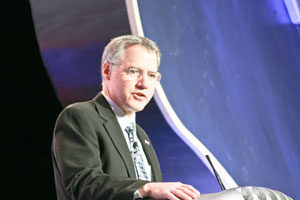“We have to grow these markets and have access. The currencies and policies, all those things have influence,” Blach said of the global market where 28 percent of all protein traded comes from the U.S. “We need another 3 to 4 million cows in order to do what we do, to maintain that same market share of global trade today.”
Blach said producers should keep their eye on global population figures, not only for food production but also fuel, automobiles and other produced items. Those factors go into the financial decisions of lenders and are passed on to beef producers. He repeatedly reminded the crowd that risk management must be a part of all business plans, with costs increasing and banks loaning more cash to an industry with tighter margins.
“All of your risks have quadrupled here in the last 10 years,” he said. “The amount of money it takes to operate, whether you’re a cow/calf producer, a stocker/operator or a cattle feeder, it’s up 60 percent in three years time for the margin operators. We have to be able to lay that risk off.”
Blach reminded producers that the surge in calf prices is only part of the equation in their push for profitability. To manage the margin, input prices will be just as volatile. In looking at 2011, Blach said that 40 percent of the time producers saw a $30-per-head change in the spot market from week to week just on live cattle. “That same 40 percent of the time, we’ve got a $20 change in the value of corn that goes into the ration. That’s $50 of uncertainty in the spot market.
“These are dangerous times when we get everybody running the same direction, and there are dangers to be aware of. All markets have corrections and this one will be no different. It’s easy to see how optimistic we can be, and thrilled to see the opportunity to expand the cowherd, over next several years. But we still have to be mindful of risks at hand.”
Blach said the market’s surge for beef production especially bodes well for younger producers, and noted their high attendance at NCBA was a sign of strong job market.
“We’ve needed to put another generation of young people out on the land. In the '80s and '90s we didn’t do that because there wasn’t much opportunity in this business. Beef demand declined 50 percent from 1980 to 1988, and none of us want to go through those times again.
“We need to make sure decisions you make have the integrity of the product in mind and that we have the faith of the consumer.” ![]()
PHOTO
TOP RIGHT: CattleFax CEO Randy Blach. Staff photo.









